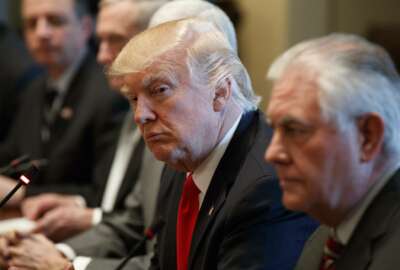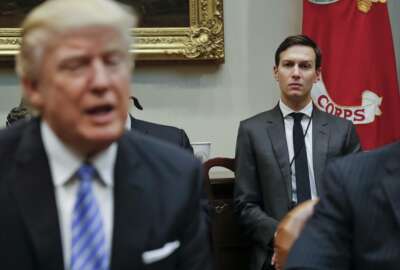
Exclusive
White House tech leaders conduct listen, learn with federal CIOs
Multiple sources say Chris Liddell, the assistant to the president for strategic initiatives, and Matt Lira, the special assistant to the president for innovation...
Federal chief information officers from every Cabinet agency, large agency and a select few small agencies made a trip to the White House over the last month to provide a 30-minute brain dump to the Trump administration.
Multiple sources say Chris Liddell, the assistant to the president for strategic initiatives, and Matt Lira, the special assistant to the president for innovation policy and initiatives, brought in CIOs one after another to get a handle on priorities, challenges and opportunities in each agency and governmentwide.
Sources say the mostly one-sided conversation let the CIOs expand and explain in more detail their one-page-or-so State of Federal IT the Obama administration left for the new technology executives.
“It was a good conversation,” said one CIO, who participated in the conversation and asked for anonymity in order to talk to the press. “I thought it was encouraging that someone coming into government without a lot of government experience wanted to learn what we were doing. There were no action items that came out of it. It was just opening their eyes to just how big and complex our jobs are.”
During a time when there is a dearth of information about the Trump administration’s management agenda and technology priorities, these meetings are a good sign.
There’s definitely a growing impatience in the federal community about the lack of movement, especially around the federal CIO, the federal chief technology officer, and whether or not the federal chief information security officer will be retained — my sources are telling me it will not, but no final decision has been made.
Keep in mind, President Barack Obama appointed Vivek Kundra as federal CIO in early March 2009 and Aneesh Chopra as federal CTO in mid-April. President George W. Bush waited until June to named his federal CIO — then called the associate director for IT and e-government — Mark Forman.
So the Trump administration really isn’t that far behind.
Might the federal community be a little impatient?
The fact that Liddell and Lira brought in CIOs to listen and learn should provide some confidence that a technology agenda is in the works. Liddell and Lira may end up being the technology leads in the White House as both are working for Jared Kushner, the assistant to the president and President Donald Trump’s son-in-law, under the new Office of American Innovation, created on March 27.
Could Liddell or Lira eventually become the federal CIO? It’s unclear.
Sources say the Trump administration seems to think having a federal CIO makes sense and seems willing to keep it.
One source said the Trump folks are reviewing several potential candidates, but it’s been quiet over the last month or so.
The smart money would be on someone who has experience in a large enterprise and understands many of the moving pieces in the government, including the budget process and where Congress fits into the discussion.
No matter who becomes the federal CIO, the fact is the Trump folks are taking the right steps to understand what challenges they face today and in the future.
Liddell took part in the CIO Council meeting in February and asked questions then. This led to these one-on-one conversations, several sources confirmed. Additionally, acting federal CIO Margie Graves played a role in getting the meetings set up, sources confirmed.
Another CIO, who also requested anonymity, said a lot of what Liddell and Lira wanted to do with these meetings was understand the role of CIOs in agencies.
“Based on their questions, I got the feeling they were still trying to wrap their heads around CIO authorities and why CIOs couldn’t do what they wanted,” the CIO said. “They mentioned in industry CIOs have control over all IT. I’m not sure that’s the case, but I wasn’t going to argue that point. They asked questions about the Federal IT Acquisition Reform Act (FITARA) and whether it’s helping CIOs get their arms around IT spending.”
Tony Scott, the former federal CIO, worked with Liddell at Microsoft and General Motors. He said Liddell is interested in accelerating IT modernization efforts as they recognize the vulnerabilities created from both cost and cybersecurity perspectives.
“Chris, being a CFO type, is highly interested in cost savings, and you can’t blame him for that,” Scott said in an interview with Federal News Radio. “He was particularly probing on how that would work and what could be done to accelerate the savings.”
Scott said he encouraged Liddell to start the IT modernization effort by creating a bunch of shared services to remove the pressure of running common back-office functions that all agencies do, including email, network security and data centers.
“I’ve heard that the OMB staff went through a series of exercises to do some estimating on what could be saved if some of those things are done,” Scott said. “There is strong financial motivation behind all of this. No question about it. Chris also is interested in the procurement side and likely will focus on these arcane processes in the government. My guess is some high percentage of this work is financially-oriented, but I know he and others get the precarious nature of legacy stuff from a cyber perspective and functionality.”
The second CIO said Liddell and Lira did ask about shared services and how best to make this concept work across the government.
Another federal executive familiar with their agency’s meeting with Liddell and Lira built on what Scott said. The White House leadership was interested in how best to reduce the cost and risk of legacy technology to let agencies focus more on innovation.
The executive said Liddell and Lira asked about cloud, software-as-a-service and what were some of the barriers stopping agencies from modernizing IT.
The CIOs and federal executives I talked to for this article were pleased with the meetings and the opportunity to explain where they are today and where they want to head in the short- and long-term.
The first CIO said the meeting was “extremely positive” and gives them “good optimism to work collaboratively” with the White House and with other agencies going forward.
“I think it was good they reached out to CIOs,” the second CIO said.
Scott said he’s optimistic about the Trump administration’s IT direction. He would like to see Rep. Will Hurd (R-Texas) reintroduce the Modernizing Government Technology (MGT) bill soon.
“I think the Trump administration folks like the core premise of the idea. The details will get worked out, but I think they are pretty supportive of the basic concept [of the IT modernization bill].”
Return to the Reporter’s Notebook
Copyright © 2025 Federal News Network. All rights reserved. This website is not intended for users located within the European Economic Area.
Jason Miller is executive editor of Federal News Network and directs news coverage on the people, policy and programs of the federal government.
Follow @jmillerWFED
Related Stories






